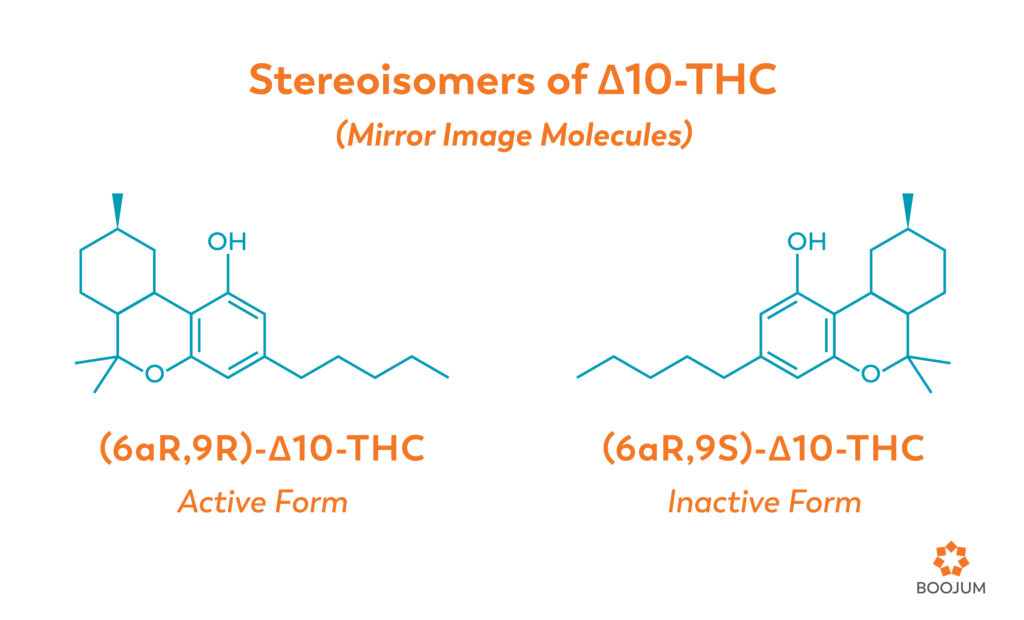A lot has been said lately about the new cannabinoids showing up in the Utah market. With so little information on what they are, how they are made, and what they can do in the human body, there is reason to be anxious about these new molecules and what their presence means to the products they show up in. But knowledge is power, so let’s talk about the facts.
First of all, let’s be clear on what we’re talking about. Utah’s Department of Agriculture and Food recently positively identified several cannabinoids that are considered poorly characterized because they’ve not been used or researched in depth.1 These cannabinoids include two stereoisomers of delta-10-THC (that means they are mirror images of each other). There is one psychoactive version (named “(6aR,9R)-delta-10-THC”. Easy name to remember, right?) And that version’s inactive opposite (named “(6aR,9S)-delta-10-THC”)2. UDAF also identified another cannabinoid, known as delta-6a,10a (that’s a single cannabinoid, though it also has two mirror-image versions, “9R-delta-6a,10a-THC” and “9S-delta-6a,10a-THC”1, and is sometimes just called “Delta-3” because that makes perfect sense.)3
Derivative cannabinoids can sometimes be considered synthetic; however, they are the result of modifications done to natural cannabinoids, as opposed to molecules manufactured to mimic cannabinoids. By introducing chemical and mechanical processes, cannabinoids like CBD can be engineered to change into more psychoactive molecules like Delta-8-THC, creating a gray area when it comes to safety and legislation5. Even though derivatives are a natural product of cannabis, it’s important to remember that they are molecules that are available only in very low concentrations naturally.

So, delta-10 and delta-6a,10a cannabinoids are found naturally in cannabis, but in VERY small amounts.4 Recently, testing labs here in Utah began showing up with large percentages of unidentified cannabinoids in their results.1 They found that these unknowns were appearing in the samples of companies that were intentionally making derivative cannabinoids, but also, in the samples of companies using high heat to distill delta-9-THC from ethanol extracts. It took further investigation and some new tests to narrow down these unidentified cannabinoids to delta-10 and delta-6a,10a (two versions of each). It is likely that these cannabinoids have always been in the market in small amounts, and exist in other state markets too, but they weren’t tested for until recently.

While naturally-occurring cannabinoids have been used safely for millenia, the landscape of derivatives and synthetics is new and we still have a lot to learn. We know that some people have found delta-8 to work for them, and that some people have experienced severe side effects after consuming it.5 The dearth of research on delta-10 and delta-6a,10a puts them in the same category of “poorly characterized cannabinoids”1. Regulators are still figuring out how to deal with derivative cannabinoids like delta-8, with most mature cannabis market states either regulating it heavily or banning it completely. Utah is still navigating this tricky topic — they are currently allowed, but required products containing them to be labeled as “derivative or synthetic”
Here at Boojum, we are always tweaking our processes to make the purest medicine we can. We believe in letting science speak for itself and making decisions about our products based on research and evidence. To that end, we will not be releasing any products with synthetic or derivative cannabinoids, and we encourage Utah patients to do their research and decide for themselves what level of risk they are willing to accept. All products with these “poorly characterized cannabinoids” will now come with a warning stating that “This product contains derivative or synthetic cannabinoids.” It’s always a good idea when dealing with your health to be informed. Ask to see COAs for products, talk to pharmacists and pharmacy agents, and always scan the cannabinoid content and ingredients to know exactly what you are consuming.
Work Cited
- https://ag.utah.gov/2022/11/03/udaf-issues-statement-regarding-synthetic-and-derivative-cannabinoids/
- Mechoulam, R., Devane, W. A., & Glaser, R. (2019). Cannabinoid geometry and biological activity. Marijuana/Cannabinoids, 1-34.
- https://www.acslabcannabis.com/blog/processing-new-cannabinoid-spotlight-delta-6a10a-thc-aka-delta-3
- Compton, D. R., Prescott Jr, W. R., Martin, B. R., Siegel, C., Gordon, P. M., & Razdan, R. K. (1991). Synthesis and pharmacological evaluation of ether and related analogs of. DELTA. 8-,. DELTA. 9-, and. DELTA. 9, 11-tetrahydrocannabinol. Journal of medicinal chemistry, 34(11), 3310-3316.
- https://www.sltrib.com/news/2021/10/13/unbeknownst-some-utah/
